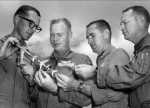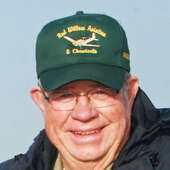- Sweatshirts, Jazzercise, and an unforgiving political climate (11/19/24)
- After the election: Lessons from history (11/5/24)
- Candy or cash: candidates and causes trick-or-treat for donations (10/29/24)
- You are fired! (10/1/24)
- Enduring heritage: Model Tís and Nebraskaís Unicam (9/24/24)
- YMCA project, coming changes and another attack (9/17/24)
- Class of '55 to share memories for Heritage Days (9/10/24)
Opinion
McCook's Mackay Trophy winner
Monday, June 26, 2006

Mackay Trophy winners in 1967, from left, Maj. John Casteel, Capt. Richard Trail, Capt. Dean Hoar, Master Sgt. Nathan Campbell demonstrate history's first multiple air refueling.
Each year the National Aeronautic Association aw-ards a trophy to officers of the U.S. Air Force for the "most meritorious flight of the year," one of the Air Force's most prestigious honors. This award was established in 1912 by Clarence Mackay, a prominent American industrialist, a philanthropist, and an avid aviation enthusiast.
The Mackay Trophy is now on permanent display at the National Air and Space Museum in Washington, D.C. It is a handsome 3-foot high silver cup, resting on a mahogany base and features four winged figures surrounding the trophy, each holding a type of pusher-biplane. Silver shields with winners' names are affixed to the base, and each recipient receives an engraved gold medal to commemorate his/her achievement.
Recipients of the Mackay trophy read like a Who's Who of aviation history in the United States, for instance, 1921, Lt. John Macready, for establishing a world altitude record of 34,509 feet, flying a Fokker T-2., 1925, Lt. James Doolittle for establishing a record of 232.573 miles an hour, flying a seaplane in the Schneider Cup Race., 1947, Capt. Charles Yeager for the first supersonic flight of the XS-1 at Muroc Army Air Field., 1956, Capt. Iven Kincheloe for flying the Bell X-2 to an altitude higher than had ever been reached in a piloted aircraft.
Over the years, most of the awards have been given for flights that broke world's records in various ways, and generally expanded the frontiers of aviation. But in 1967, Capt. Dick Trail, of McCook, Co-pilot of a KC-135 tanker aircraft, was awarded the Mackay Trophy for a significant flight of an entirely different nature.
America's wars have generally been fought far from America's shores, and maintaining a supply line for supplies and munitions for our troops has been a major logistic problem. During World War II, American bombers traveled long distances over oceans and enemy occupied territory, to reach their bombing targets.
There was a constant trade-off between carrying extra bombs and carrying enough fuel to make the return to home base successfully.
With the smaller fighter planes it was more of a problem. The fighters simply did not have the fuel capacity to provide protection to the bombers on long bombing runs and still make it back to home base. Though aerial fuelings had been completed successfully since the '20s, it was not until the Vietnam War in the1960s that the United States Armed Services developed practical, though sophisticated systems of refueling planes from airborne tankers.
During the Vietnam War all of the U.S. fighter-bombers required aerial refueling. Early in the war, in 1964, at a U.S. Air Base near Saigon, guerillas destroyed five B-57 bombers and one helicopter, and badly damaged 13 other bombers and six other helicopters. Clearly, it was necessary to house U.S. aircraft at safer, albeit more remote airfields. Eventually the U.S. Air War was conducted from three points, Thailand, Guam and Naval Aircraft Carriers -- all many miles from North Vietnam. SAC tankers based in Thailand, Okinawa, the Philippines and Taiwan made Vietnam the first "tanker war" By the late '60s, the U.S. Air Force was waging its air war mainly with McDonnell F-4 Phantoms, which required refueling from KC-135 tankers, both going in and returning from a mission.
The Navy provided Grumman KA-6 tankers for refueling its Navy planes, which were mainly based on carriers. Air Force tankers were not allowed to refuel Navy planes, and visa versa, and in fact were not generally equipped to refuel the other's planes.
Since both the Air Force and the Navy were operating in the same area sometimes it was possible for an Air Force tanker to come to the aid of a distressed Navy plane -- which was against the rules. Those rules made no sense to the Air Force and Navy pilots, who felt that they were on the same side in the war against the North Vietnamese, and did come to the aid of their comrades, even though it was a Court Martial offense. It was only after a rescue that the pilots attempted to "cook the books" to cover up where their offloads of precious fuel had gone.
On April 13, 1967 Dick Trail, a Co-pilot on a KC-135 tanker, engaged in a classic case of emergency refueling, involving both Air Force and Navy planes. He and his crew were able to replenish two Navy KA-3 tankers, who were completely dry of fuel. While in the process of pumping fuel to one of the Navy tankers, two Navy F-8 fighters came on the scene, desperate for fuel.
For a time, as Dick's plane was refueling the Navy tanker, the tanker in turn was refueling the F-8 fighters -- a tri-level refueling, a first in aviation history.
That day, Trail's KC-135 pumped fuel to two Navy tankers, two Navy F-8s and two AF F-4s, returning from a strike, in addition to its own 104s, 14 refuelings in all.
Without the service from Trail's AF tanker, the Navy planes probably would not have been able to return to their carrier base.
But when the refueling operation was over Dick's tanker did not have enough fuel to fly back to its base in Okinawa, and was forced to put down at DaNang, on the coast of South Vietnam. This time there was no way to alter the records saying where the fuel had gone.
Even landing the tanker at DaNang was forbidden by the Air Force. It was felt that their big tanker would be like a magnet to enemy mortars and guerilla fire.
Rumors were rampant about a court martial for Dick's KC-135 crew for all the rules they had broken by coming to the Navy's rescue. Trail and his crew were brought before a review board, who acknowledged their heroic action with the Navy men, while at the same time citing the number and the gravity of their actions in failing to follow Air Force rules.
As Trail's crew of the KC-135 left Southeast Asia to return to the United States they still did not know whether they would receive a medal -- or a court martial.
Later, when word of the possible court martial for the crew came back to the Pentagon in Washington, Navy officials let it be known that the Trail's KC-135 crew might be eligible for the high honor of Navy Cross, which of course would be highly embarrassing for the Air Force if they were conducting a court martial for the same event.
This proved to be enough to stifle further talk about an Air Force court martial.
At the end of the year Dick and his crew of the KC-135 received their due -- they were awarded the Distinguished Flying Cross by the Air Force, as well as the prestigious Mackay Trophy, given by the Air Force for "the most extraordinary aerial flight of the year" -- the first time a tanker crew had been so honored.
One of the things of which Trail is most proud is the fact that since the Vietnam War there has been markedly increased cooperation between the Air Force, Army, and Navy, sparked in no small part by incidents such the one herein described.
The pity is that it took so long to come about. How many additional lives might have been saved?

